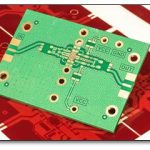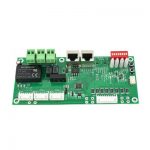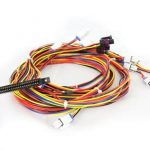What are PCB Phototools?
PCB phototools, also known as photomasks or film positives, are essential components in the production of printed circuit boards (PCBs). These tools are used to transfer the designed circuit pattern onto the PCB substrate during the photolithography process. Phototools are typically made of transparent film or glass, with the circuit pattern printed on them using opaque ink or chrome.
Types of PCB Phototools
There are two main types of PCB phototools:
-
Film Positives: These are the most common type of phototools used in PCB Fabrication. They are made of transparent film, usually polyester, with the circuit pattern printed on them using opaque ink. Film positives are relatively inexpensive and easy to produce, making them a popular choice for small to medium-scale PCB Production.
-
Glass Photomasks: Glass photomasks are used for high-precision PCB fabrication, particularly in the production of high-density or fine-pitch circuit boards. These phototools are made of glass substrates coated with a thin layer of chrome. The circuit pattern is etched onto the chrome layer, creating a highly accurate and durable phototool. Glass photomasks are more expensive than film positives but offer superior resolution and durability.
The Role of Phototools in PCB Fabrication
Phototools play a critical role in the PCB fabrication process. They are used to transfer the designed circuit pattern onto the PCB substrate during the photolithography step. Here’s a brief overview of how phototools are used in PCB fabrication:
-
PCB Design: The first step in PCB fabrication is designing the circuit layout using electronic design automation (EDA) software. The design is then exported as a set of Gerber files, which contain the information needed to create the phototools.
-
Phototool Creation: The Gerber files are used to create the phototools. For film positives, the circuit pattern is printed onto the transparent film using a high-resolution printer. For glass photomasks, the circuit pattern is etched onto the chrome layer using a photomask writer.
-
Photoresist Application: The PCB substrate, typically a copper-clad laminate, is coated with a light-sensitive material called photoresist.
-
Exposure: The phototool is placed on top of the photoresist-coated PCB substrate, and the assembly is exposed to UV light. The opaque areas of the phototool block the UV light, while the transparent areas allow the light to pass through and expose the photoresist.
-
Development: After exposure, the PCB substrate is developed in a chemical solution. The exposed areas of the photoresist are dissolved, revealing the underlying copper layer.
-
Etching: The developed PCB substrate is then etched in a chemical solution, typically ferric chloride or ammonium persulfate. The exposed copper is removed, leaving behind the desired circuit pattern.
-
Stripping and Finishing: Finally, the remaining photoresist is stripped away, and the PCB undergoes various finishing processes, such as solder mask application, silkscreen printing, and surface finishing.
Factors Affecting Phototool Quality
Several factors can affect the quality of PCB phototools and, consequently, the quality of the resulting PCBs. These factors include:
-
Resolution: The resolution of the phototool determines the minimum feature size that can be accurately reproduced on the PCB. Higher resolution phototools, such as glass photomasks, can produce finer details and smaller features compared to lower resolution phototools like film positives.
-
Dimensional Stability: Phototools must maintain their dimensions and shape during the exposure process to ensure accurate pattern transfer. Film positives are more prone to dimensional changes due to temperature and humidity fluctuations compared to glass photomasks.
-
Optical Density: The optical density of the opaque areas on the phototool determines how well they block UV light during exposure. Higher optical density results in better contrast and sharper edges on the developed photoresist.
-
Defects: Any defects on the phototool, such as scratches, pinholes, or dust particles, can lead to defects on the resulting PCB. Careful handling and storage of phototools are essential to minimize the risk of defects.

Choosing the Right Phototool for Your PCB Project
When selecting a phototool for your PCB project, consider the following factors:
-
PCB Complexity: The complexity of your PCB design will determine the type of phototool needed. Simple, low-density designs can be produced using film positives, while complex, high-density designs may require glass photomasks.
-
Production Volume: For small to medium-scale production, film positives are usually sufficient and cost-effective. Glass photomasks are more suitable for high-volume production runs, where the higher initial cost is offset by the improved durability and consistency.
-
Budget: Film positives are less expensive than glass photomasks. Consider your project budget when choosing a phototool type.
-
Turnaround Time: Film positives can be produced relatively quickly, while glass photomasks may have longer lead times due to the more complex manufacturing process.
Phototool Maintenance and Storage
Proper maintenance and storage of phototools are essential to ensure their longevity and maintain the quality of the resulting PCBs. Here are some tips for phototool maintenance and storage:
-
Handling: Always handle phototools with clean, lint-free gloves to avoid contamination and minimize the risk of scratches or other damage.
-
Cleaning: Regularly clean phototools using a soft, lint-free cloth and an appropriate cleaning solution, such as isopropyl alcohol. Avoid using abrasive materials or harsh chemicals that can damage the phototool surface.
-
Storage: Store phototools in a clean, dry, and temperature-controlled environment. Use protective covers or containers to prevent dust accumulation and minimize the risk of scratches or other physical damage.
-
Inspection: Regularly inspect phototools for any signs of wear, damage, or contamination. Replace phototools that show significant deterioration to maintain the quality of your PCBs.
Frequently Asked Questions (FAQ)
- What is the difference between a film positive and a glass photomask?
-
Film positives are made of transparent film with the circuit pattern printed using opaque ink, while glass photomasks are made of glass substrates coated with a chrome layer, onto which the circuit pattern is etched. Glass photomasks offer higher resolution and durability compared to film positives but are more expensive.
-
Can I use a regular printer to create film positives?
-
While it is possible to use a regular printer to create film positives, it is recommended to use a high-resolution printer specifically designed for phototool production. These printers can produce film positives with higher optical density and better edge definition, resulting in higher quality PCBs.
-
How long do PCB phototools last?
-
The lifespan of a PCB phototool depends on various factors, such as the type of phototool, the frequency of use, and the storage conditions. With proper maintenance and storage, film positives can last for several hundred exposures, while glass photomasks can last for thousands of exposures.
-
What resolution should I choose for my PCB phototools?
-
The required resolution for your PCB phototools depends on the minimum feature size and complexity of your PCB design. For most standard PCB designs, a resolution of 8,000 to 16,000 dpi is sufficient. However, for high-density or fine-pitch designs, resolutions of 20,000 dpi or higher may be necessary.
-
Can I reuse PCB phototools for multiple projects?
- Yes, PCB phototools can be reused for multiple projects as long as they remain in good condition. However, it is essential to inspect the phototools regularly for any signs of wear or damage and to replace them when necessary to maintain the quality of your PCBs.
| Phototool Type | Advantages | Disadvantages |
|---|---|---|
| Film Positives | – Lower cost – Faster production – Suitable for small to medium-scale production |
– Lower resolution – Less durable – More prone to dimensional changes |
| Glass Photomasks | – Higher resolution – More durable – Better dimensional stability |
– Higher cost – Longer production time – More suitable for high-volume production |
In conclusion, PCB phototools are critical components in the PCB fabrication process, enabling the accurate transfer of circuit patterns onto the PCB substrate. Choosing the right type of phototool, ensuring proper maintenance and storage, and understanding the factors that affect phototool quality are essential for producing high-quality PCBs. By following best practices and selecting the appropriate phototool for your project, you can optimize your PCB fabrication process and achieve reliable, high-performance electronic devices.






Leave a Reply